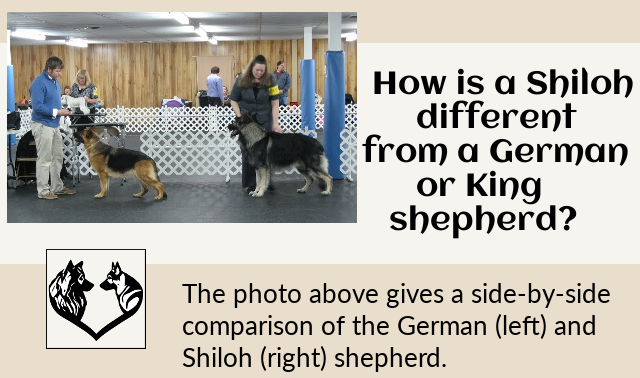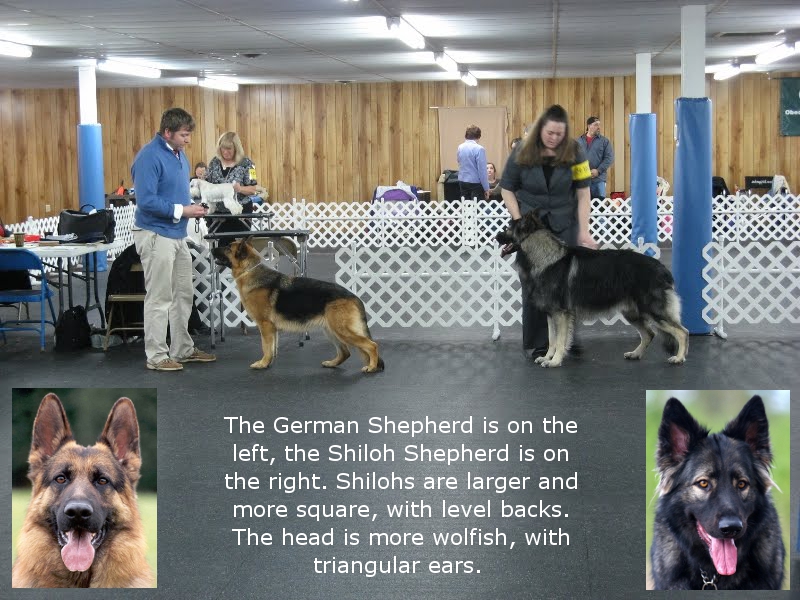
How is a Shiloh Shepherd different from a German Shepherd or a King Shepherd?
There are three parts to this: genetics, appearance, and temperament. Let’s tackle genetics and breeding program first, because it’s the reason the other two things are different.
Genetics and Breeding Objectives
Like all modern dog breeds, Shilohs are a mixture of breeds: German shepherd, Sarplaninac, Malamute, Canadian White Shepherd, Altdeutscher Schaeferhunde, and more. The introduction of these other breeds took them away from the German shepherd in appearance, genetics, and temperament.
However, unlike most other breeds, the ISSA Shiloh continues to introduce outside breeds into our pool for health and diversity, carefully breeding the offspring back to Shilohs to regain breed type. Nowadays dog breeders are starting to realize that mixing in other breeds—outcrossing—can be important for purebred health. These new infusions of blood continue to make our Shilohs different from all other shepherd breeds. You can read about our outcrossing in our section all about the ISSA’s Genetic Diversity Project!
Our breed founder, Tina Barber, also had very different goals than the German shepherd breeders. She bred for a softer, calmer, more family-friendly temperament instead of a working temperament, and created a special program called LMX to improve our dogs' hips. Over 40 years of development has set these traits into the Shiloh.
The King Shepherd breed founder was a Shiloh Shepherd breeder who felt she had a different vision for the breed. She split from the ISSR organization and renamed her dogs King Shepherds. One of their registry sites notes that Great Pyrenees and a limited amount of Akita was added to King Shepherds, and they have continued their breeding program with different priorities than the Shiloh program (see the temperament description, below).
Differences in Appearance
Most Shilohs are significantly larger than GSD’s of the same sex. Our breed standard calls for two inches more in height than the German shepherd standard. Shilohs also have smaller, triangular ears, and less of a square head, more “wolfy” in appearance. They are not as long in the body as German shepherds. The long “plush” coat is the most popular coat type in Shilohs, unlike in German shepherds where the long coat exists but is not the standard.
Kings are generally the same size as Shilohs; their breed standard puts them at slightly shorter on average, but heavier. They are predominantly long-haired; though the standard permits a smooth coat, they are very rare. Their heads are specifically broad and square, per their standard. The ears are larger on average, and not specified to be triangular, so in general the King head is not as “wolfy” as the Shiloh head. They consider white dogs faulty and disqualify them, unlike Shilohs.
Below you can see a photo taken in 2010 of a German Shepherd and a Shiloh Shepherd side by side in the show ring, with inserts detailing the different head and expression.

Differences in Personality and Temperament
Due to selective breeding for a more family-friendly shepherd dog, Shiloh shepherds are noticeably calmer and easier to handle than most working shepherd breeds, including many German shepherds. Though higher energy and higher drive do exist within the breed, and some individuals are capable of working at demanding tasks such as Search and Rescue work, overall the Shiloh is not a “working” breed and as breeders we aim instead for a calmer, social, multi-talented companion dog. Shilohs are also “softer” in temperament than German shepherds, being more amenable to going with the flow and less likely to be a training challenge to their owners.
The King Shepherd per their breed standard is not primarily a companion dog, but a livestock-guardian dog without peer. With that defined as their purpose, the temperament required for that job is more independent and more strong-willed than the Shiloh. Livestock guardian breeds can be a little harder to train because of this independence. The breeds chosen for their outcrosses (Great Pyranees and Akita) reflect this shift in temperament and purpose.
- You can go to our Breeders page here!
- You can read about the Shiloh Shepherd temperament, and how to communicate to your breeder what sort of pup would be ideal for you here, in our Shiloh temperament guide!
- You can go back and read general information about Shiloh Shepherds here.
- You can go back to the Alliance page here.